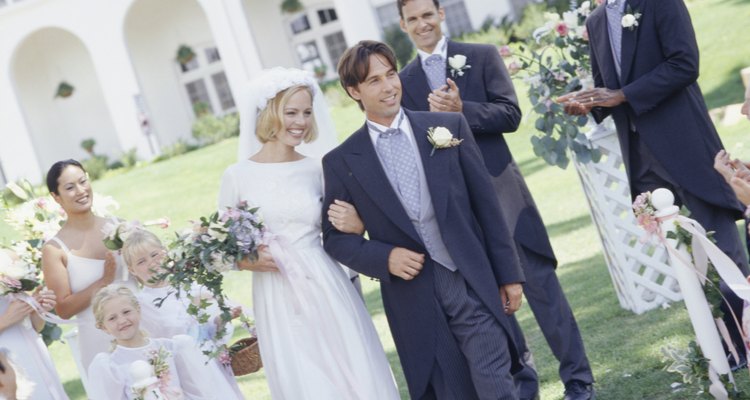
Jupiterimages/Pixland/Getty Images
Your ceremony is the most beautiful and moving part of your wedding day. If you acquaint yourself with the way a ceremony is conducted and plan the order of your processional and recessional, you'll present an impressive picture to your guests.
The Basics

Comstock/Comstock/Getty Images
If your ceremony will be held in a church, temple or other place of worship, the priest, rabbi, minister or other officiant will advise you as to ceremony procedure. If it's in a reception hall that's doubling as a ceremony site, the manager or event planner will be able to assist you with questions about dressing rooms, waiting areas, placement of musicians, public-address system or any other location-related issues. Your officiant will answer your questions about anything that takes place during the ceremony itself.
If you have a wedding planner, she'll be at your rehearsal to get everyone into position and to advise you about processional order and timing. The officiant will conduct the ceremony portion of the rehearsal, going over the order of ceremony elements, taking you through a rehearsal of your vows, making sure the best man knows when to hand the rings to the groom and that the bride and groom know when to walk back down the aisle together.
If you don't have a wedding planner, it's a good idea to ask a reliable friend or relative to help you at the ceremony location. Making sure the bridesmaids, maid of honor, flower girl and ring bearer are in place at the beginning of the ceremony, and that the groom and groomsmen enter on cue, is something you don't want to leave up to chance. If you don't have attendants, you'll still want to have a "go-to" person to cue the musicians or start the recorded music, help your guests with anything they might need, and make sure the bride and groom have their rings and are both ready to go.
The Processional

Buccina Studios/Photodisc/Getty Images
The groom and groomsmen usually enter the ceremony area first. The groom takes his place, the best man stands next to him, and the groomsmen line up beside the best man in the order they'll be recessing, from first to last. The bridesmaids enter from the rear, or from the end of whatever aisle has been created for the occasion, in the reverse order that they'll be recessing. For example, if Sally will be the last bridesmaid to recess, she walks down the aisle first and takes the farthest spot away from where the bride will stand. The maid of honor follows the bridesmaids and takes her place next to where the bride will stand. She's followed by the flower girl(s) and the ring bearer.
The bride, of course, comes last. As a rule, whatever music has been played for the attendants stops, and the bridal processional music begins, then the bride walks down the aisle. She can be accompanied by one or both parents, a relative or friend, or she may walk alone.
This processional order can vary based on whether you're including religious traditions in your wedding. If your officiant belongs to a particular faith or denomination, consult her about the traditional processional order.
The Ceremony

Buccina Studios/Photodisc/Getty Images
When the bride reaches the groom, and her father, mother or other relative is "giving her away," the officiant asks the question, the giver responds and places the bride's hand in the groom's. He then takes his seat. If the bride has chosen not to be given away, her escort simply takes his seat and she joins the groom, after handing her bouquet to her maid of honor.
During the ceremony, the couple should stand facing each other. They may hold hands, or just stand with their arms relaxed at their sides. Most brides and grooms naturally reach for each other's hands during this emotional time. The officiant will lead them through the ceremony and, at the appropriate time, will "feed" their vows to them so that they can repeat them. If you prefer, you can memorize your vows, but make sure your officiant has a copy of them. This is a highly charged moment, and it's very common for brides and grooms to stumble over their vows. That doesn't detract from the beauty of the ceremony; in fact, it adds a charming touch. But you'll want to have some prompting to make sure you say the words you chose so carefully.
When it's time to exchange rings, the officiant will prompt the best man, if necessary, and he'll give the rings to the groom. The groom keeps the bride's ring and gives his ring to her. As they repeat ring vows, they follow the officiant's instructions to place the rings on each other's fingers.
The Recessional

Buccina Studios/Photodisc/Getty Images
After the couple has been pronounced husband and wife, to cheering and applause, the maid of honor hands the bride's bouquet to her, the bride takes the groom's arm, the music begins and they walk down the aisle together. The maid of honor takes the best man's arm, they wait until the bridal couple has reached the end of the aisle, and they recess. Each bridesmaid-groomsman couple then follows in the same way.
The flower girls and ring bearers usually have been seated during the ceremony, since they're too young to be expected to stand quietly during the proceedings. They can recess with the rest of the bridal party or not, as they wish.
If the couple has chosen to have a receiving line, they wait at the back of the church or ceremony area and greet their guests, one by one, as they leave their seats. If it's a large wedding, just a few words are necessary so that the line keeps moving. If it's a small wedding, the couple may want to chat longer with each guest.
Related Articles

How to Give the Groom His Wedding Band

What Is the Difference Between a ...

How to Announce a Newly Married Couple

When Does the Mother of the Bride Go ...

Wedding Etiquette for Widowed Parents

Wedding Ceremony Sequence of Events

What Are the Duties of the Groom's Aunt ...

Who Gives a Toast at the Rehearsal ...

When Is It Time to Play the Wedding ...

How to Introduce a Wedding Party

Wedding Processional Etiquette for the ...

Bridesmaid & Groomsmen Traditional ...

How to Coordinate a Wedding Ceremony

How to Get Your Mom & Grandma to Stop ...

Traditional Duties of a Maid of Honor ...

Religious Sand Ceremony

How to Honor the Deceased Mother of the ...

What Should a Minister Wear to Perform ...

How to Give the Bride Away

Bridal Shower Blessing Ideas
Writer Bio
Margaret Morris has a Bachelor of Arts in English with a concentration in creative writing from the University of Pittsburgh. She also holds a celebrant certificate from the Celebrant Foundation and Institute. Morris writes for various websites and private clients.
Photo Credits
Jupiterimages/Pixland/Getty Images